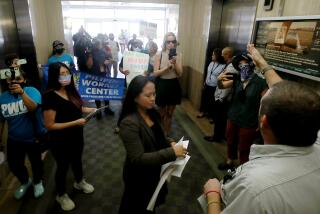Tax Incentives Key to Welfare Reform, State Panel Says
SACRAMENTO — For welfare reform to work in California, state and federal government leaders must take aggressive steps to create jobs by enacting tax incentives to encourage small businesses to hire the poor, a state task force will recommend today.
At the same time, the group will propose that local governments streamline their distribution of benefits by setting up electronic transfer systems that would allow recipients to receive aid through an ATM-like card that they could use to buy food, pay the baby-sitter or meet the rent.
The recommendations appear in a 22-page report to be issued today by the Work Opportunity Response Commission, a 21-member group appointed by state Controller Kathleen Connell to study the economic consequences of the new federal law that restructures the nation’s decades-old welfare system.
Connell said in an interview that the group’s recommendations, which touch both federal and state tax laws, already have been forwarded to the White House and will be presented to state lawmakers, who will have to approve legislation to put them into effect.
“Make no mistake about it--welfare reform will not succeed if we think the job creation chapter will write itself,” Connell wrote in the opening chapter of the report.
Consisting of business executives, labor officials and government leaders--including seven county supervisors, two state senators and one assemblyman--the bipartisan task force studied the new welfare law with a particular focus on provisions requiring recipients to move from welfare to work.
The report reflects an eight-week effort and is the first significant proposal for implementing the new welfare law from state government.
The Wilson administration, by contrast, has taken a go-slow approach to the new welfare law, saying it wants to consider all aspects of the legislation and have federal guidelines in place before it recommends a comprehensive plan.
As viewed by the task force, the daunting challenge of the new welfare law will be the creation of enough jobs to move recipients from welfare to work without violating the deadlines prescribed by the law.
The law requires able-bodied adults on welfare to be engaged in some work activity within two years. It penalizes states that fail to move specific percentages of these adults into jobs by reducing the amount of their federal grants.
The percentage of welfare recipients who must work to maintain benefits escalates each year, beginning with a requirement that 25% of single adults be engaged in some form of work by next July. That number increases to 50% in 2002.
In California, where 97% of companies employ fewer than 200 people, the report said the state’s ability to move recipients into jobs will depend primarily on small businesses, particularly in rural areas where the welfare reforms may be hardest to implement.
*
But the report said President Clinton’s proposal for a tax credit to provide an incentive for companies to hire long-term welfare recipients does not apply to many of these small businesses.
The president’s plan would give businesses a 50% tax credit on the first $10,000 in wages earned by a long-term welfare recipient. But the report said that would not be an incentive in California, because 40% of businesses declare net operating losses each year.
The task force recommended altering the president’s proposal by allowing companies to elect to receive a federal refund of up to 50% of the credit amount or a maximum of $2,500.
As a second option, the report said companies should be allowed to apply the credit back as far as three years or forward as far as 15 years, so it could be used in a profitable year.
The report proposed that the state offer a state welfare-to-work tax credit that is similar to the federal credit, but only a third of its value.
Connell said the legislation will have to be carefully worded so that businesses will not be encouraged to fire those already working to make way for welfare recipients and tax credits that they provide.
“The most sensitive issue that we have to deal with here in California is how not to disadvantage the working poor, who have struggled to be independent and have not received the support of welfare benefits,” she said.
Connell said her group would also be pushing county welfare departments to take advantage of new technology to reduce the mountains of paperwork following each welfare recipient.
She said the group will urge counties to use electronic cards, much like a credit or ATM card, which would be coded with each recipient’s benefits. The cards would be used during the transition period, as recipients move from welfare to work.
Called a “smart card,” Connell said, the electronic device would reduce fraud by requiring the use of passwords.
More to Read
Inside the business of entertainment
The Wide Shot brings you news, analysis and insights on everything from streaming wars to production — and what it all means for the future.
You may occasionally receive promotional content from the Los Angeles Times.










